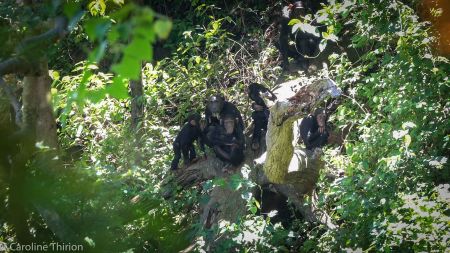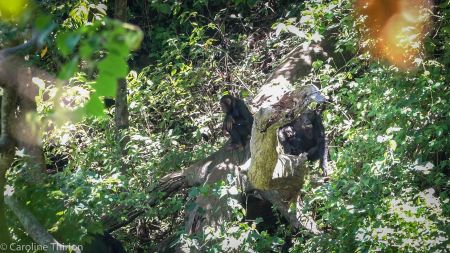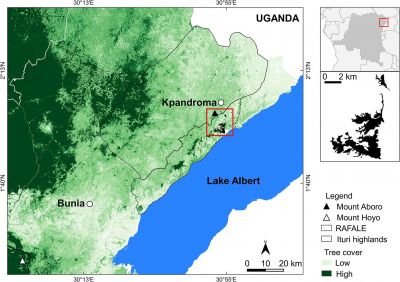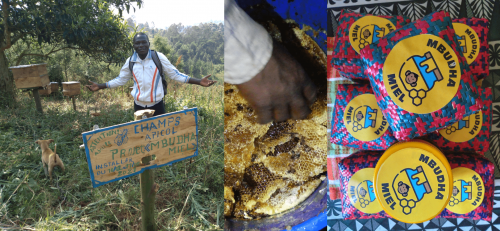RAFALE (Refuge Altitude Forests of the Albert Lake Escarpment)
Central Africa > Democratic Republic of the Congo > Refuge Altitude Forests of the Albert Lake Escarpment (RAFALE)
Summary
- Eastern chimpanzees (Pan troglodytes schweinfurthii) are present in Refuge Altitude Forests of the Albert Lake Escarpment.
- The population size is unknown.
- The population trend is unknown.
- The site covers approximately 500 km².
- Key threats to chimpanzees are human encroachment, habitat degradation and destruction, and hunting traps intended for other species.
- Conservation activities have focused on education and awareness raising, involvement of the local community in research and conservation activities.
Site characteristics
The site consists of forest fragments located along the Congolese Albertine Rift slope. It is known as the RAFALE landscape (Refuge Altitude Forest Fragments of the Albert Lake Escarpment) to distinguish it from the Ituri highlands, which have altitudes ranging from 1,700 m up to 2,455 m at Mount Aboro (Meessen 1951). A vast area of the Ituri highlands is classified as an IBA (code CD007, 410,000 ha, <8% protected - 2001 criteria met A1, 2 and 3) and Alliance For Zero Extinction - based on existing KBA boundaries and due to the historical presence of the Lendu crombec (IUCN CR - Sylvietta chapini) and the Lendu plateau clawed frog (IUCN CR - Xenopus lenduensis). None of the fragments within the RAFALE landscape are currently protected.
The RAFALE landscape consists of a mosaic of 20 semi-deciduous montane forest fragments (>0.5km² each) comprising a total forested surface area of ±70km2 (Laudisoit et al. 2021). They form a string, which is oriented southwest-northeast along 80 km of steep slopes on the western side of Lake Albert, ranging from an elevation of 620 m at Lake Albert to 2,020 m above sea level on the highest ridge. Each of the fragments is a riverine gallery forest surrounded by open grassland savannah, fallow land and crop fields, with streams that flow into a central river that empties into Lake Albert. These forest fragments are characterized as high-altitude closed-canopy strips with a moderately dense understory (10-50 m horizontal visibility). Depending on the altitude, the average daily temperature varies from 17-25°C and the annual average precipitation ranges from 1,200-1,700 mm. A short rainy season, characterized by heavy rainfall, occurs between March and the end of May, and a long rainy season occurs between August to mid-November (Messen 1951).
Besides a large community of Eastern chimpanzees, named the Mbudha community, eight other primate species have been observed (direct observations, small mammal live trapping, camera trapping), cited here by decreasing frequency of observation: Cercopithecus mitis stuhlmannii, Cercopithecus ascanius schmidti, Papio anubis, Lophocebus albigena johnstoni, Piliocolobus oustaleti (Hart et al. 2019). It is possibly a hybrid zone for P.o. tephrosceles / oustaleti (Tom Struhsaker, pers. comm.), Chlorocebus pygerythrus, Colobus guereza occidentalis, and Galagoides cfr. thomasi (handled by chimpanzees , not known if eaten or actively hunted by the local chimpanzee community (Hicks et al. 2019). Total estimated forest cover and suitable habitat for chimpanzees: ±70km2, of which ±20km2 have been explored with scientific objectives (preliminary inventory, habitat description, density estimation). Considering the mosaic of forest patches, shrubland, savanna and wetland on the shores of Lake Albert, the site covers approximately 500 sq.km (Laudisoit et al. 2021).
Other remarkable species thriving up to 2000 m include two species of pangolins (EN – IUCN; Phataginus tricuspis and P. tetradactyla; (Khwaja et al. 2019)), a duiker (Cephalophus rufilatus), crested porcupine (Hystrix cristata), Heterohyrax brucei, Jackson's mongoose Bdeogale jacksoni, dwarf scaly-tailed squirrels (Anomalurus pusillus), elephant shrew (Rhynchocyon sp.), and least dwarf shrew (Suncus infinitesimus). The provisional full mammalian inventory consists of 60 species with 9 Primates, 9 Carnivora, 1 Afrosoricida, 2 Cetartiodactyla, 1 Hyracoidea, 2 Pholidota, 19 Rodentia, 6 Eulipotyphla, 1 Macroscelidae and 10 Chiroptera (Laudisoit et al. 2021). These records represent new locations for most species as well as known geographic range limits.
Table 1. Basic site information for RAFALE
| Area | 500 km² |
| Coordinates | 1.937869 N, 30.899338 E |
| Designation | Unclassified ( Proposed community managed forest reserve) |
| Habitat types | Subtropical/tropical moist montane forest, subtropical/tropical high altitude shrubland, permanent freshwater later, dry savanna, rocky areas (inselbergs, escarpment) |
IUCN habitat categories Site designations
Ape status
Between 2015 and 2017, preliminary surveys were conducted in and around three fragments named Tsili-Bai forest (or FG1), Rogo-Zalu forest (FG2) and Dolokpa-Dzoo forest (FG3) covering ±18.15 km2 (Laudisoit et al. 2021). The presence of chimpanzees in relict forest fragments of the Congolese Albertine Rift region — determined in November 2015 based on informal discussion with local inhabitants — was unexpected. In March, June, August and September 2016, and in April 2017, a total of 14 unplanned pilot walks following the path of least resistance were conducted (Laudisoit et al. 2021). In August 2016 and April 2017, a structured investigation was carried out to estimate the density of chimpanzees in three forest fragments and the nest encounter rates (Laudisoit et al., 2021). Based on the identifications of individuals made over the course of the study period (2016-2017), the minimum size of the Mbudha community was determined to be 42 weaned chimpanzees and 10 infants. A total of 283 chimpanzee nests were recorded (123 along transects and 160 on the pilot walks). The mean number of nests per kilometer was 4.3 (min=0 and max=14.3) and 18.4 (min=0 and max=43.6) on pilot walks and transect surveys respectively (Laudisoit et al. 2021). Using the truncated dataset of 117 nests recorded along the six transects we surveyed between 1,100 and 1,700 m altitude, we estimated a density of 4.62 weaned chimpanzee individuals per km² (Uniform simple polynomial). This chimpanzee community was named “Mbudha”, which in Bbaledha (Badha or Lendu) language means “the water of the chimpanzees”.
Table 2. Ape population estimates in RAFALE
| Species | Year | Abundance estimate (95% CI) | Density estimate [ind./ km²] (95% CI) | Encounter rate (nests/km) | Area | Method | Source | Comments | A.P.E.S. database ID |
|---|---|---|---|---|---|---|---|---|---|
| Pan troglodytes schweinfurthii | 2015 | FG1 | Interview method, acoustic detection | Laudisoit et al. 2021 | No survey, first acoustic detection of chimpanzees | ||||
| Pan troglodytes schweinfurthii | 2016-2017 | 4.3 | FG1, FG2 and FG3 | Index survey (reconnaissance walk) | Laudisoit et al. 2021 | Preliminary surveys in FG1, FG2 and FG3. Survey effort: 37.6 km | |||
| Pan troglodytes schweinfurthii | 2016-2017 | 18.4 | FG1, FG2 and FG3 | Line transects (Distance) | Laudisoit et al. 2021 | Survey effort: 6.7 km. | |||
| Pan troglodytes schweinfurthii | 2017 | FG3 | Direct observation | Laudisoit et al. 2021 | Recorded 2 hr of live observation. First live observation of 18 members of the Mbudha community. |
Threats
The Mbudha chimpanzee community is not the only one surviving along the Lake Albert escarpment as reported by locals, but recurrent militia’s incursions in the Djugu and Mahagi territories have impeded the exploration of western forest fragments. As local people do not eat nor hunt chimpanzees, which they consider “as close to human beings that they could live in the village“, the major threats are population growth (natural and internally displaced), habitat degradation and destruction, mainly due to poverty and ignorance of the forestry code causing illegal logging and slash-and-burn agriculture. Huyghe (2017) estimated that about 1.2% of the natural habitat and forest cover is lost each year over the three explored fragments. While chimpanzees are not targeted by snares, snare mutilations have been observed on 12 individuals caught on camera trap footage, and in 2020, a young chimpanzee was found dead with a snare around its neck.
Table 3. Threats to apes in RAFALE
| Category | Specific threats | Threat level | Quantified severity | Description | Year of threat |
|---|---|---|---|---|---|
| 1. Residential & commercial development | Unknown | ||||
| 2. Agriculture & aquaculture | 2.1 Annual & perennial non-timber crops | High | Habitat loss due to expansion of slash-and-burn agriculture (Laudisoit et al., 2021). | Ongoing (2021) | |
| 3. Energy production & mining | High | Charcoal production (Laudisoit et al. 2021). | Ongoing (2021) | ||
| 4. Transportation & service corridors | Low | ||||
| 5. Biological resource use | 5.1 Hunting & collecting terrestrial animals | Medium | Chimpanzees are injured or killed by traps that are intended for other animals (Laudisoit et al. 2021). | Ongoing (2021) | |
| 6. Human intrusion & disturbance | Present | ||||
| 7. Natural system modifications | Present | ||||
| 8. Invasive & other problematic species, genes, diseases | Unknown | ||||
| 9. Pollution | Absent | ||||
| 10. Geological Events | 10.3 Avalanches/landslides | Low | Destruction of suitable chimpanzee nesting sites following a landslide (News24 2017). | 2017 | |
| 11. Climate change & severe weather | Unknown | ||||
| 12. Other options | Absent |
Conservation activities
The Mbudha team is sensitizing the population around the fragments about the potential by-catch of chimpanzees by their hunting techniques and are encouraging smaller and alternative traps use in the forested area.
Table 4. Conservation activities in RAFALE
| Category | Specific activity | Description | Year of activity |
|---|---|---|---|
| 1. Residential & commercial development | Not reported | ||
| 2. Agriculture & aquaculture | 2.11. Farm more intensively and effectively in selected areas and spare more natural land | Encourage and develop a no-cost local organic manure, introduce agro forestry and soil stabilization with rapid growth trees (e.g. Acacia mearnsii). | Expected to start (2021) |
| Experimental tree nursery development in available land using species of rapid growth. | Expected to start (2021) | ||
| 3. Energy production & mining | Introduction of alternative sources of energy. Cassava ethanol burner being tested – Cassava ethanol production feasibility studies are ongoing. | Ongoing (2021) | |
| 4. Transportation & service corridors | Not reported | ||
| 5. Biological resource use | Reduced snare use in forested area, sensitization and informal interview to identify targeted mammal species. | Ongoing (2020) | |
| 5. Biological resource use | Establish core zones where snare use will be prohibited and logging banned upon decision and agreement between grouping and community chiefs. | Expected to be achieved by the end of 2021 | |
| 6. Human intrusion & disturbance | Not reported | ||
| 7. Natural system modifications | Sensitization at national, provincial and grouping level. Consultation with provincial and national authorities (Ministry of environment, Land security and Tourism) for supporting the locally managed reserve protection and delineation. | Ongoing (2020) | |
| 8. Invasive & other problematic species, genes, diseases | Not reported | ||
| 9. Pollution | Not reported | ||
| 10. Education & Awareness | 10.1. Educate local communities about primates and sustainable use | Includes citizen science project (cybertracker), create a pedagogic space within the local institution, develop educational activities about zoochory with local institutions and schools, supervision of local MSc students. | Ongoing (2021) |
| 10.2. Involve local community in primate research and conservation management | Local community members trained in ecological monitoring, placing camera traps and gathering data.Establish a permanent base and office in the local higher institution. The Mbudha garden is based on zoochory by animals – local tree nursery based on seeds collected in vertebrate feces. | Ongoing (2021) | |
| 11. Habitat Protection | 11.5. Create/protect forest patches in highly fragmented landscapes | Writing of a conservation plan for a community managed reserve. | Ongoing (2021) |
| 12. Species Management | Not reported | ||
| 13. Livelihood; Economic & Other Incentives | 13.2. Provide non-monetary benefits to local communities for sustainably managing their forest and its wildlife (e.g. better education, infrastructure development) | 30 beehives have been installed, which provide sustainable funding for the Mbudha team, the health centers of the villages located around the forest, and the conservation project including compensation for forest protection to local chiefs. | Ongoing (2021) |
| 13. Livelihood; Economic & Other Incentives | 13.3. Run research project and ensure permanent human presence at site | Chimpanzee research | Ongoing (2021) |
Conservation activities list (Junker et al. 2017)
Challenges
Frequent incursions of unidentified militias in the region preventing access to the study site (road blocks) or discouraging funders and researchers to invest in a long term project.
Table 5. Challenges reported for RAFALE
| Challenge | Source |
|---|---|
| Habitat degradation and loss due to poor governance and ignorance of the forestry code. | Laudisoit pers. comm. |
| Incursions by external individuals or organizations encouraging logging and providing saw chains to speed up the logging work. | Laudisoit pers. comm. |
| Stigma leading to lack of support and funding due to bad reputation of the area (red zone, security issues) however an unbiased approach to working in the area with civilians leads to successful projects. | Laudisoit pers. comm. |
| Lack of technical means | Laudisoit pers. comm. |
Research activities
Laudisoit and local colleagues (the Mbudha team) are seeking support to establish a permanent research site in the area and, with the support of the local communities, are developing income generating activities to support forest protection. They hope to attract other research projects on the Congolese Albertine Rift and in the Ituri highlands where other scientifically undocumented population of apes and primates are known and reported by locals. Research is ongoing and Anne Laudisoit is currently supported by a National Geographic Explorer’s grant (NGS-61178C-19).
Documented behaviours
Table 6. Ape behaviors reported for RAFALE
| Behavior | Source |
|---|---|
| Making ground nests | Laudisoit et al. 2021 |
| Rock licking | Laudisoit pers. comm. |
| Meat eating | Hicks et al. 2019 |
External links
Mbudha, in the chimpanzees’ footsteps
Facebook Mbudha Chimps
Chimpanzees surviving in a fragmented high-altitude forest landscape of the Congolese Albertine Rift
New Population of Eastern Chimpanzees Discovered in Remote Congolese Mountain Forests
Relevant datasets
References
Hart, J., Maisels, F., Oates, J.F., Laudisoit, A., Hicks, T.C., & Struhsaker, T.T. (2019). Piliocolobus oustaleti The IUCN Red List of Threatened Species 2019.
Hicks, T.C., Menken, S.B.J., Laudisoit, A.,& Hart, J. (2019). Chapter 1. Handling and Consumption of Vertebrate Prey by Chimpanzees (Pan troglodytes schweinfurthii) in the Northern Democratic Republic of the Congo. Chimpanzee Behaviour: Recent Understandings from Captivity and the Forest Central Washington University, Ellensburg, WA USA. Friends of Washoe, Ellensburg, WA, USA. : Mary Lee Abshire Jensvold, PhD (Editor). ; 2019. p. 218.
Khwaja, H., Buchan, C., Wearn, O.R., Bahaa-el-din, L., Bantlin, D., Bernard, H., et al. (2019). Pangolins in global camera trap data: Implications for ecological monitoring. Global Ecology and Conservation, 20:e00769.
Laudisoit, A., Huyghe., P., Willie., J., et al. (2021). Chimpanzees surviving in a fragmented high-altitude forest landscape of the Congolese Albertine Rift. Conservation Science and Practice, 3:e403. https://doi.org/10.1111/csp2.403
Meessen, J.M.T. (1951). Monographie de l'Ituri (Nord-est du Congo belge) : histoire, géographie, économie. In: Direction de l'agriculture df, de l'élevage et de la colonisation, 1951., editor. Congo (Democratic Republic): Belgium. Ministère des affaires africaines. p. 305.
News24. (2017, August 25). Up to 250 feared dead in DRC mudslide. https://www.news24.com/news24/africa/news/up-to-250-feared-dead-in-drc-mudslide-20170825
Page completed by: Dr. Anne Laudisoit Date: 01/11/2021



